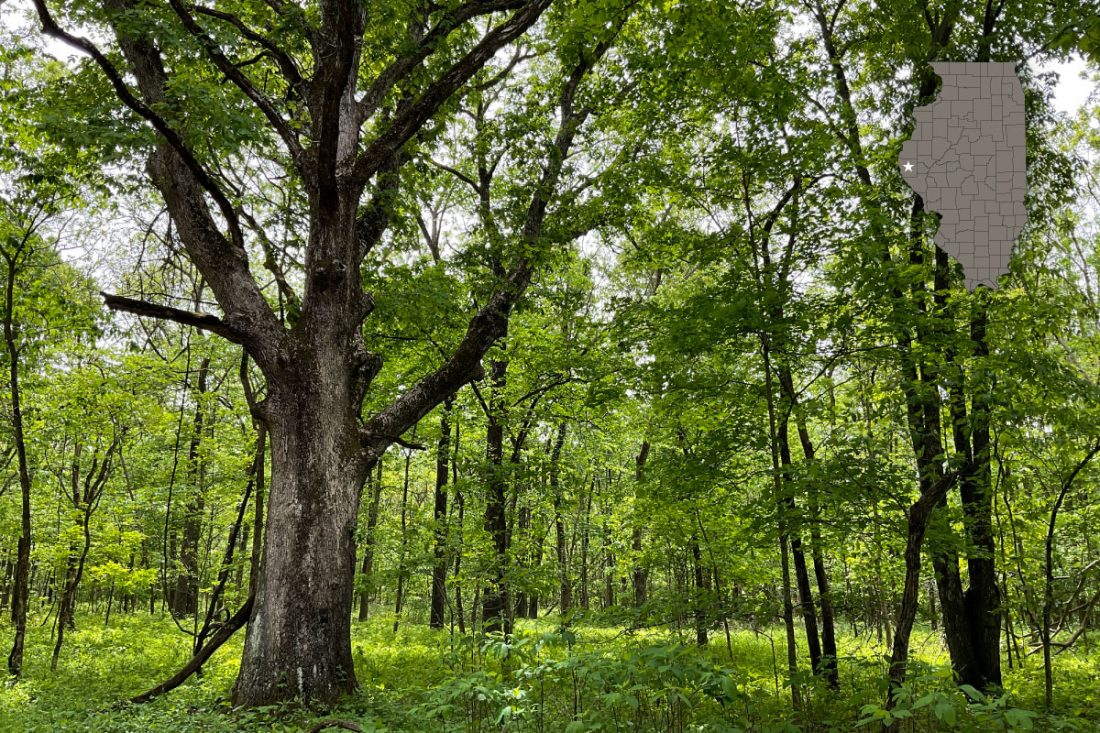
Photo by Kathy Andrews Wright.



Photo by Kathy Andrews Wright.
Located in Clayton (Adams County), the 3,000-plus acre Siloam Springs State Park is the perfect place to visit for those who want to explore the Western Forest-Prairie Natural Division. Within the park, visitors can find multiple opportunities to view and explore the remnant oak-hickory forests, open woodlands, savannas and prairies present in the strongly dissected glacial till plain of the Western Forest-Prairie Natural Division.
According to the Illinois Department of Natural Resources (IDNR), the Siloam Springs State Park site was originally part of a military tract in western Illinois and was set aside to be given to combat veterans. The land encompassing Siloam Springs State Park was initially acquired in 1852 by George Meyers for his service in the Black Hawk and Mexican wars. In 1935, the Siloam Springs Recreation Club purchased the site to provide a recreational area for local citizens. By 1940, local concerned citizens raised enough money to provide needed funding, and the process to make it a state recreation area began. Construction began on an earthen dam across a deep ravine in 1954, creating a 58-acre lake. Siloam Springs was dedicated as a state park in 1956.
One of the most fascinating aspects of Siloam Springs State Park is that it is a “bat hotspot,” according to Ray Geroff, IDNR Natural Heritage Biologist.
“Everything comes together just right for bats at Siloam Springs,” Geroff explained. “The site has just the right mix of prominent and suitable trees for nesting and roosting, as well as adjacent grasslands and prairies where bats can feed.” Seven of the 13 species of bats known from Illinois have been documented at Siloam Springs, including both the state and federally endangered Indiana bat and the state and federally threatened northern long-eared bat.
Geroff further explained that the northern long-eared bats have been the subject of multiple research efforts at Siloam Springs, including an ongoing long-term cooperative research project between Illinois College in Jacksonville and IDNR.
Heading up the current ongoing project is Dr. Bryan Arnold from Illinois College. In the spring of 2022, preliminary findings for this study were presented at the Illinois State Academy of Science annual meeting. The research project explores the effects of prescribed burns on bat activity and species composition in the riparian and upland habitats in Siloam Springs State Park.

Prescribed burns are a long-accepted habitat management technique where the forest understory is routinely burned. Prescribed burns certainly are beneficial in removing invasive and weedy species and promoting the growth of native species, but the research project is designed to determine if prescribed burns have unintended consequences for native wildlife populations.
Populations of forest-dwelling bats have been on the decline due to multiple factors, including White-nose Syndrome, habitat loss and degradation, and, more recently, the possible impact of wind farms. Are we unintentionally adding to the list of threats to these bats’ existence in our effort to improve their habitat?
Bat activity throughout both riparian and upland areas of Siloam Springs State Park is measured acoustically using six recorders. Each recorder is placed at a unique site, some in areas that were burned in the calendar year of data collection or burned the previous year. Others are positioned in areas that have never been burned.
According to Geroff, the goal is to collect recordings every two weeks during a set period. Once the recordings are collected and analyzed, the acoustic recorders are moved to a different site in each burn category. Data is analyzed to determine if any bat passed the recorder during a two-week period and to identify the species by its echolocation call.

“Initial results are very promising,” Geroff said. “So far, bat activity has increased in the areas where we have been doing the prescribed burns, possibly because flight corridors have been opened up, but also potentially because an increased insect population is providing more food for the bats.”
It is hoped that determining the areas where the highest bat activity levels are found can be used to further refine the prescribed burn schedules.
“Maybe we will learn that less frequent burns are better for these bats rather than every two years,” Geroff explained. “Or maybe we’ll learn annual burns are better.”
From research to recreation, Siloam Springs State Park is the place to visit for those who want to explore and learn more about the Western Forest-Prairie Natural Division. Home to a varied terrain including woodlands, uplands, forested ravines, a lovely lake, and carefully maintained facilities, Siloam Springs State Park can easily be considered one of the most beautiful parks and destinations in Illinois. Recreational enthusiasts will find multiple opportunities for hunting, angling, camping and bird watching. Plan your visit today, and maybe if your timing is right, you will be treated to the sight of those very special bat inhabitants!
Gretchen Steele hails from Coulterville. Steele is a freelance outdoor communicator. Her award-winning work appears as a regular columnist and contributing feature writer for Illinois Outdoor News and several Illinois newspapers. She enjoys spending her time afield as a volunteer for the Illinois Department of Natural Resources, Delta Waterfowl Foundation, Retrievers Unlimited, and various other conservation organizations. Steele is a member of the Illinois Conservation Federation Outdoor Hall of Fame. She is the Past President of Missouri Outdoor Communicators and remains an active member. Steele is a current and active member and formerly served on the Board of Directors with Association of Great Lakes Outdoor Writers.
Submit a question for the author